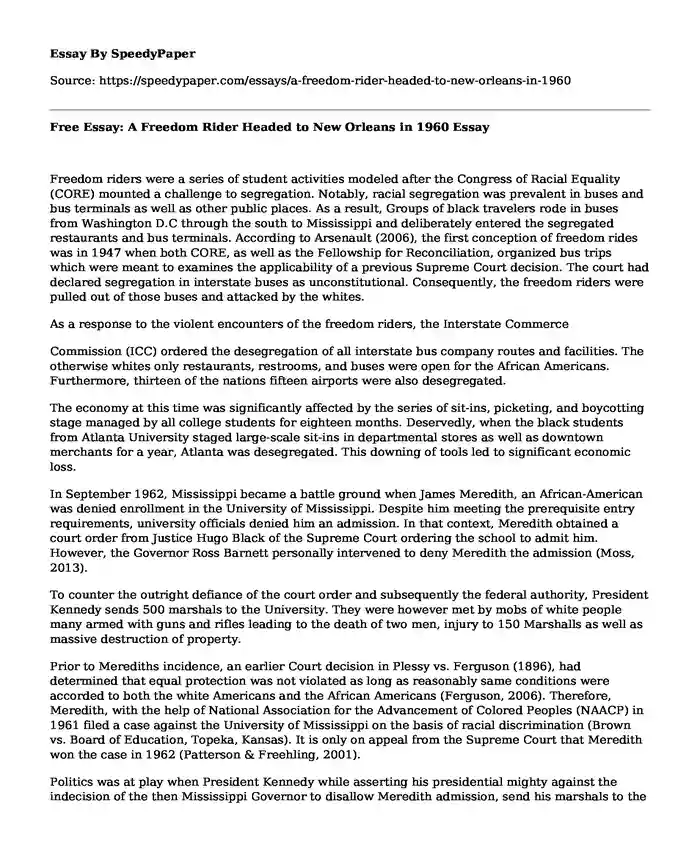Freedom riders were a series of student activities modeled after the Congress of Racial Equality (CORE) mounted a challenge to segregation. Notably, racial segregation was prevalent in buses and bus terminals as well as other public places. As a result, Groups of black travelers rode in buses from Washington D.C through the south to Mississippi and deliberately entered the segregated restaurants and bus terminals. According to Arsenault (2006), the first conception of freedom rides was in 1947 when both CORE, as well as the Fellowship for Reconciliation, organized bus trips which were meant to examines the applicability of a previous Supreme Court decision. The court had declared segregation in interstate buses as unconstitutional. Consequently, the freedom riders were pulled out of those buses and attacked by the whites.
As a response to the violent encounters of the freedom riders, the Interstate Commerce
Commission (ICC) ordered the desegregation of all interstate bus company routes and facilities. The otherwise whites only restaurants, restrooms, and buses were open for the African Americans. Furthermore, thirteen of the nations fifteen airports were also desegregated.
The economy at this time was significantly affected by the series of sit-ins, picketing, and boycotting stage managed by all college students for eighteen months. Deservedly, when the black students from Atlanta University staged large-scale sit-ins in departmental stores as well as downtown merchants for a year, Atlanta was desegregated. This downing of tools led to significant economic loss.
In September 1962, Mississippi became a battle ground when James Meredith, an African-American was denied enrollment in the University of Mississippi. Despite him meeting the prerequisite entry requirements, university officials denied him an admission. In that context, Meredith obtained a court order from Justice Hugo Black of the Supreme Court ordering the school to admit him. However, the Governor Ross Barnett personally intervened to deny Meredith the admission (Moss, 2013).
To counter the outright defiance of the court order and subsequently the federal authority, President Kennedy sends 500 marshals to the University. They were however met by mobs of white people many armed with guns and rifles leading to the death of two men, injury to 150 Marshalls as well as massive destruction of property.
Prior to Merediths incidence, an earlier Court decision in Plessy vs. Ferguson (1896), had determined that equal protection was not violated as long as reasonably same conditions were accorded to both the white Americans and the African Americans (Ferguson, 2006). Therefore, Meredith, with the help of National Association for the Advancement of Colored Peoples (NAACP) in 1961 filed a case against the University of Mississippi on the basis of racial discrimination (Brown vs. Board of Education, Topeka, Kansas). It is only on appeal from the Supreme Court that Meredith won the case in 1962 (Patterson & Freehling, 2001).
Politics was at play when President Kennedy while asserting his presidential mighty against the indecision of the then Mississippi Governor to disallow Meredith admission, send his marshals to the University. Moreover, political mighty was exercised again when Vivian Malone and James Hood tried to enroll at the University of Alabama. Notably, when the governor stood at the entrance of the universitys Hall Carmichael to deny the two from entry, the president used a stronger force of the native black and white Alabama soldiers.
From the preceding discussion, racial discrimination was the social factor that presented itself during the freedom riders era. The segregation of the whites from the African Americans right from restaurants, bus terminals to even universities was the social paradigm that the freedom riders sought to shift. They succeeded in doing so in June 1963 when the civil rights bill was passed. The bill eliminated segregation in public accommodation as well as public schools.
References
Arsenault, R. (2006). Freedom riders: 1961 and the struggle for racial justice. Oxford University Press.
Ferguson, P. V. (2006). Plessy v. Ferguson (1896).
Moss, G. D. (2013). Moving on: the American people since 1945. Pearson Higher Ed.
Patterson, J. T., & Freehling, W. W. (2001). Brown v. Board of Education: A civil rights milestone and its troubled legacy. Oxford University Press.
Cite this page
Free Essay: A Freedom Rider Headed to New Orleans in 1960. (2019, May 28). Retrieved from https://speedypaper.net/essays/a-freedom-rider-headed-to-new-orleans-in-1960
Request Removal
If you are the original author of this essay and no longer wish to have it published on the SpeedyPaper website, please click below to request its removal:
- Essay Example on the Value Statistical Life
- John Nash and Schizophrenia - Free Research Paper Example
- Essay Example: Racial Segregation in Commercial Ads
- Free Essay: Why Online Learning is Effective
- Essay Sample on Product Failure Research
- Paper Example. Support Groups for Survivors of Suicide
- Free Essay. The Type of Art and Work That Hassan Wants to Create
Popular categories





